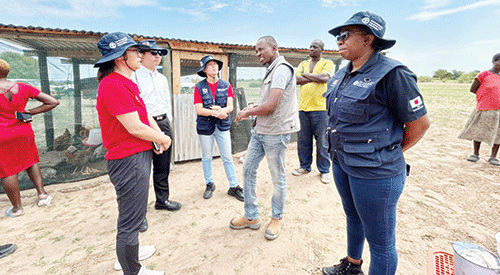Sawi Hausiku
NKURENKURU – Japanese ambassador to Namibia, Hisao Nishimaki and Food and Agriculture Organisation Country Representative Qingyun Diao visited vulnerable households at Musese village in the Kavango West Region on Friday.
Nishimaki revisited one of the beneficiary households he visited two years ago, where that time he identified the necessity of assisting the family. The house is headed by an unemployed single mother, who lives with her three disabled children. The family said they were given a project of 100 chickens of which five have so far died. They also mentioned the challenges of water, saying the river is about three to five kilometres away, which is challenging as they have to fetch water every day.
They also said they have a problem with where the chickens are kept as it is too small, and they sometimes struggle with feed too.
During the visit, Nishimaki was shown the donated poultry project and the family in return expressed their gratitude and appreciation for the kind donation from the Government of Japan.
Nishimaki said one of the agricultural interventions that the Government of Japan is implementing in Namibia with the Ministry of Agriculture through the JICA project, is called Namibia Smallholder Empowerment and Promotion focusing more on market-oriented agriculture.
“It is basically meant to promote farming as a business, in order to change the farmers’ mindset on marketing from just ‘grow and sell’ to ‘grow to sell’ – meaning one must produce what the market wants and not just keep to what one is used to produce traditionally,” said Nishimaki.
Qingyun meanwhile highlighted that through the funding, the FAO has provided direct interventions to small-scale farmers, such as drought-tolerant seeds, water-saving technologies like drip irrigation, solar pumps, and support for poultry farming.
“I encourage all beneficiaries to adopt sustainable agricultural practices, such as conservation agriculture. These methods will ensure one continues to cultivate and harvest successfully,” she said.
The project, which was implemented in March 2024 at a cost of N$14 million covering Ohangwena, Kavango East and Kavango West assisted four households in Musese village with poultry set up which includes building materials, chicken houses, 100 chickens, water tanks and a supply of chicken feed. This was done through the emergency response project meant to enhance resilience building to improve livelihoods, and food and nutrition security of the most vulnerable households in Namibia.
-Nampa


